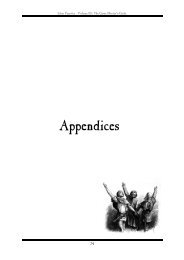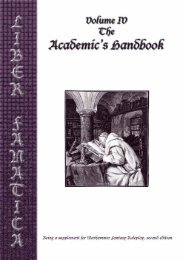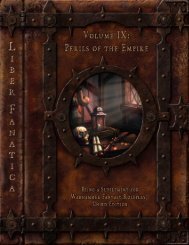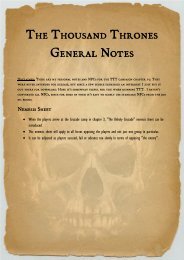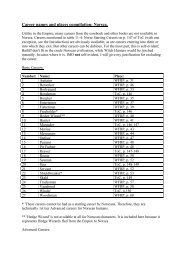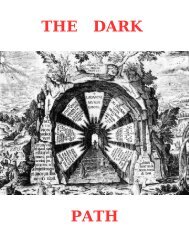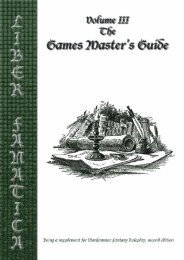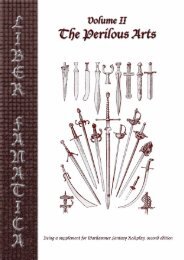1.56 MB Download - Liber Fanatica
1.56 MB Download - Liber Fanatica
1.56 MB Download - Liber Fanatica
Create successful ePaper yourself
Turn your PDF publications into a flip-book with our unique Google optimized e-Paper software.
<strong>Liber</strong> <strong>Fanatica</strong> - Volume IV: The Academic’s Handbook<br />
Example: Pietr has started research into the<br />
Philosopher’s Stone and research dictates that 3<br />
ingredients mixed correctly may be sufficient.<br />
These are Basil, Copper and Orc tusk, costing him<br />
150 gc in total. After ten days of work, Pietr<br />
attempts an Academic Knowledge (Science) test<br />
and succeeds by 45 percentiles. His resultant<br />
concoction has a 45% chance of being pure enough<br />
to take to the next stage. He rolls 54% on his<br />
Coalescence Test and sadly must start again with<br />
new ingredients.<br />
Philosopher’s Stone<br />
“If any muddiness is felt, seen and perceived in<br />
me. I am not the way I should be and I should be<br />
purified, as I was in the human body. In young<br />
and old, man and woman, in fishes, metals and<br />
all other things, I can produce great wonders. For I<br />
am the power, essence, nature and quality of all<br />
things.”<br />
Although research into the Philosopher’s Stone is<br />
often scoffed at by Gold Magisters, it remains a<br />
popular area of study for young, ambitious<br />
wizards of the order, despite being both time<br />
consuming and a sink for hard earned money. If<br />
anyone actually discovered the means to perform<br />
all the transformations required, the resulting<br />
concoction would transmute base metals into<br />
gold, and the alchemist’s name would be revered<br />
by the Gold College for ages to come.<br />
Presented here are guidelines to formalise this<br />
area of alchemical research.<br />
Each step along the formula to the Philosopher’s<br />
Stone takes 10 days to achieve. An Academic<br />
Knowledge (Science) test is required for each<br />
procedure to succeed. If the alchemist has<br />
Academic Knowledge (Magic), he may roll<br />
against both skills and keep the better result.<br />
Even if the skill tests are passed, the resultant<br />
concoction only has a percentage chance equal to<br />
the margin of success to advance the<br />
Philosopher’s Stone to the next stage of the<br />
process. This is called the Coalescence Test. If<br />
the Coalescence Test is failed, research must<br />
start again and a new set of ingredients<br />
experimented upon. Therefore it is recommended<br />
that the alchemist have several batches of his<br />
formula to work on, so that his time is not<br />
completely wasted if one Coalescence Test fails.<br />
Who said the road to riches was easy?<br />
A successful formula can be utilised after each<br />
step has been completed. These experiments act<br />
as training for the ultimate goal - transforming<br />
base metals - and can produce a variety of<br />
results. However, only the most powerful<br />
formulas can transform lead into gold. The Ritual<br />
of Transformation details how these intermediate<br />
formulas work.<br />
Many Alchemists spend years refining their<br />
techniques without much success, yet the<br />
Philosopher’s Stone remains a popular area of<br />
study.<br />
Each step of the process must have successfully<br />
coalesced before taking the formula on to the<br />
next stage. Additionally, each step must be<br />
performed in order for the formula to be<br />
advanced to the next step. You cannot, for<br />
example, perform step 1 and then skip to step 3.<br />
If at any stage a coalescence test is failed then<br />
the process must be started again at step 1 with<br />
new ingredients gained from the Alchemical<br />
Ingredients tables.<br />
The Road To Riches<br />
Step 1: Calcinatio - The alchemist incinerates his<br />
ingredients over an open flame. This transforms<br />
the ingredients into a fine powder.<br />
Step 2: Putrefactio - By adding organic material to<br />
his powder, the alchemist causes his mixture to<br />
decay, purifying the substance through<br />
destruction of its current embodiment.<br />
Step 3: Sublimatio - The alchemist evaporates his<br />
materials before re-solidifying it. This further<br />
refines the substance’s nature.<br />
Step 4: Solutio - Here, the alchemist adds<br />
Mercury to his formula, and a single sliver of<br />
gold. He heats the whole in order to change the<br />
solid matter to a liquid.<br />
Step 5: Distallatio - The alchemist then<br />
continually evaporates and condenses his<br />
mixture in a hermetically-sealed container.<br />
Step 6: Coagulatio - This step involves<br />
crystallizing the liquid into a solid body, and is<br />
also called ‘fixation’.<br />
Step 7: Extractio - In this step, the alchemist<br />
extracts the desired elements from solid matter<br />
through transmigration.<br />
Step 8: Digestio - The alchemist dissolves the<br />
remaining solid, maintaining the temperature of<br />
104 o F.<br />
Step 9: Ceratio - This step transforms the<br />
concoction into a waxy, paste-like substance.<br />
Step 10: Fermentatio - The alchemist allows the<br />
waxy substance to ferment, transforming it into a<br />
higher state of being.<br />
47





